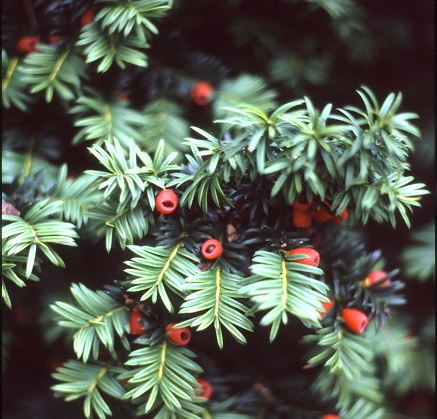 Young plants propagated from ancient and threatened yew trees and collected from around the world are being used to create a unique heritage hedge and important conservation resource in Scotland at the Royal Botanic Garden Edinburgh (RBGE). Young plants propagated from ancient and threatened yew trees and collected from around the world are being used to create a unique heritage hedge and important conservation resource in Scotland at the Royal Botanic Garden Edinburgh (RBGE).
The hedge will be created using 2,000 small trees from the common yew (Taxus baccata). Planted around the perimeter of the Garden, it will cover a kilometre in length and take an estimated 10 years to complete.
At the heart of the project are progenies of the most ancient of all, the Fortingall yew which stands in Aberfeldy, Perthshire. Estimated to be 3,000 years old, it is thought to be the oldest living tree in the UK, if not in Europe.
RBGE also has a precious collection of plants propagated from famous trees in England. These include cuttings from Down House in Kent, home of the legendary naturalist Charles Darwin, and from Borrowdale in Cumbria, made famous by William Wordsworth in his poem Yew Trees.
From Wales, there are plants from ancient yews which have stood for hundreds of years in church yards at Buttington in Powys, St Digain’s in Llangernyw and St James’s in Nantglyn, Denbighshire. Northern Ireland is represented by cuttings from the ancient yews at Crom Castle in County Fermanagh and the Republic of Ireland by small trees propagated from heritage yews at Muckross Abbey in Killarney.
The Royal Botanic Garden Edinburgh’s Martin Gardner, Co-ordinator of its International Conifer Conservation Programme, says: “This is the first time that a botanic garden will be surrounded by a conservation hedge and it is of great importance. There is a need to conserve old-growth trees and remnant populations, and to safe-guard plant biodiversity in the face of global environmental change.
“Once the hedge is established, I look forward to being asked why the yew hedge is not uniform in growth, colour and texture. My response will simply be ‘Ah, but that is biodiversity for you’.”
Among the first plantings, taking place today (8 April), are the young trees from the Fortingall yew and other famous Scottish heritage trees including Bruce’s Yew in Stirlingshire, thought to be a tree that gave shelter to Robert the Bruce and his soldiers and the John Knox yew in Renfrewshire under which it is claimed the famous reformer gave his first sermon in 1556.
Around 20 per cent of the hedge will comprise of plants grown from heritage trees. The rest will be from populations worldwide where the Taxus genus is listed nationally as threatened. In total, 14 foreign countries will be represented in the hedge including the Czech Republic, Albania and Croatia. Seed collections have also come from yew forests in Sochi, Russia as well as from Crimea.
There are many well-documented heritage old-growth yew trees to be found in churchyards and stately homes. The common yew has always played an important part in the culture of mankind through folklore, medicine, warfare and religion and represents a powerful symbol of resurrection.
|

